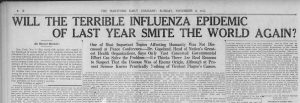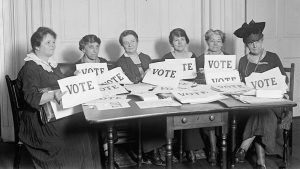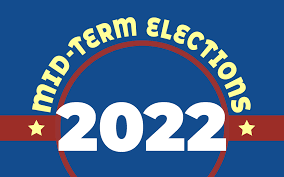The past makes sounds in history. These sounds rhyme. Yes. These sounds repeat. No, no, and no. Today, across the 102 years spanning 2021 and 1919, we’ll hear two rhymes of pandemic. I want you to remember the pair of rhymes as you move from this year now (the present) to this year next (the future). Please follow below for just a few minutes as I guide you through image and text.
…the first rhyme is mismatch…
1919 and 2021 share an important commonality. They are the second calendar years in which a pandemic occurs, unfolds, evolves, wave after wave. In both cases, in autumns of those years, the pandemics of influenza and coronavirus are on the clear decline from the worst waves of death and suffering. And yet, nerves are on edge, tensions are high, hostility between the pro- and anti-camps burns hot. You see it in the two headlines of November 2, 102 years apart but strikingly alike in season and in spirit. They rhyme in the mismatching of data and mood.
The point I want you to know is that the hard numbers and statistical data of cases, deaths, and so on are not the only determinants of consensus about the pandemic’s end. They are part of it, to be sure, but they absolutely are not all of it and—get ready for a hard truth—they may not even be the most compelling piece of it. I’ve delivered a presentation to a private group where I stated that added other “un-data-ish” element is, broadly, political and commercial in nature. When commerce and politics agree that the pandemic is over, then truly it is gone. That’s what happened in the year after 1919.
…the second rhyme is normalcy…
In 1919 the phrase “return to normalcy” was practically nonexistent. Invisible. A year later and the phrase is everywhere—in political speeches, in election campaigns, in advertisements for every item you can imagine, in conversation in bars and barber shops and banquet halls. Can’t get away from it.
Warren Harding is the originator of the phrase in 1920. First a Republican candidate for the party’s presidential nomination, then the nominee, and finally the winner of the presidential election and incoming POTUS 29, Harding spoke the phrase that soon everyone repeated. The echoes of the phrase “return to normalcy”—which of course included a national agreement that the pandemic was finally over as a national menace—grew even louder in 1921, Harding’s first year in the White House.
The act of voting for a political figure who embodied normalcy was as powerful in asserting the end of the pandemic as any scientific fact or trend. This observation takes us to our concluding point for your next sixteen months (to spring’s arrival in 2023).
As events, our election of 2022 rhymes with their election of 1920. That’s my prediction, based on history from the past. For those who participate in elections as candidates, volunteers, or voters, that’s also my advice, albeit unsolicited.
What remains to be known, what remains to be lived, what remains to be heard as a sound, is how the differences in the two elections manifest themselves. After all, a rhyme isn’t a repeat or a replay. Consider the following. Then, it was for the Presidency along with much of Congress. Now, it will be for much of Congress. Then, it was Harding as the individual symbol. Now, it will be someone else and many someone elses as a collective gaggle of individual symbols. Then, it was with the assumption that a full stride of a full presidential term lays ahead. Now, it will be with the assumption that a partial step toward the presidential competition has been completed. And so much more.
Twice rhymed. Thanks for reading. Reach out to me if you’d like via email: dan@historicalsolutions.com
All the best, Dan











